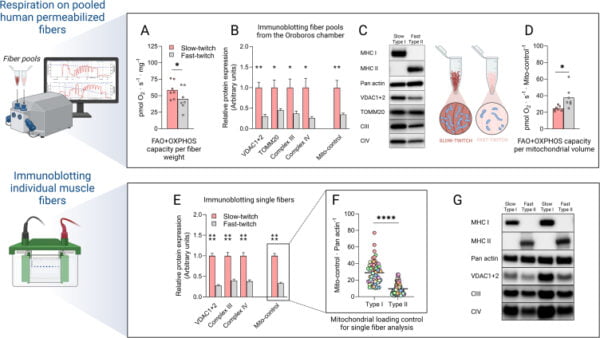In his latest science study, Svexa CSO Filip Larsen and colleagues have demonstrated that mitochondria of human fast-twitch muscle fibers compensate for their lack of volume by substantially elevating intrinsic respiratory rate. This work underpins svexa’s development of training ‘according to your muscle type’.
Background
Human skeletal muscle consists of a mixture of slow- and fast-twitch fibers with differing chemical behaviour and distinct capacities for mechanical performance. It’s well known that mitochondrial volume favors slow-twitch fibers, but data on the fiber type-specific intrinsic mitochondrial function is highly limited. Dr Larsen’s team set out remedy this. This builds on previous work on the power of adaptive training and in the detection of overtraining.
The Study
For this project, the team recruited seven healthy participants – four women and three men, ages 25-31 with VO2max 45 ± 4 ml/kg/min. Vastus lateralis muscle biopsies provided samples, and the team utilized the THRIFTY rapid fiber type identification protocol to detect, sort, and pool fast- and slow-twitch fibers within 6 h of muscle biopsy sampling. Respiration of permeabilized fast- and slow-twitch fiber pools was then analyzed with high-resolution respirometry. Using standardized western blot procedures, muscle fiber pools were subsequently analyzed for control proteins and key proteins related to respiratory capacity.

Results
- Human slow-twitch muscle fibers possess greater respiratory capacity than fast-twitch fibers
- Fast-twitch muscle fibers have lower mitochondrial density than slow-twitch fibers
- Mitochondria in fast-twitch fibers compensate for their low volume by higher intrinsic respiratory capacity
- The higher intrinsic mitochondrial capacity in fast-twitch fibers is driven by faster succinate metabolism
- Mitochondria of the fast-twitch muscle express greater levels of proteins controlling cristae structure
Svexa has developed and validated an algorithm that can accurately determine your muscle fiber type using only the historic training data from your running watch or bike computer combined with blood lactate measurements – no need for muscle biopsies, or even a physical lab test. Combined with these latest learnings, we can deliver training plans that are tailored to your specific fiber type. These are available to clients through our Ellida endurance and Thrud strength training products.
Read the full scientific study

In addition to his role as svexa’s Chief Science Officer, Dr FIlip Larsen is Associate Professor, Swedish School of Sports & Health Sciences, and a Physiologist for Swedish National Orienteering Team.



